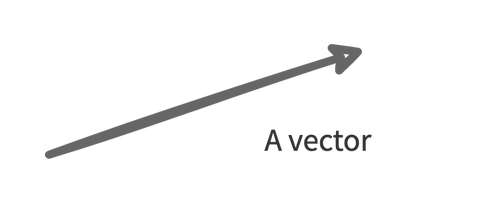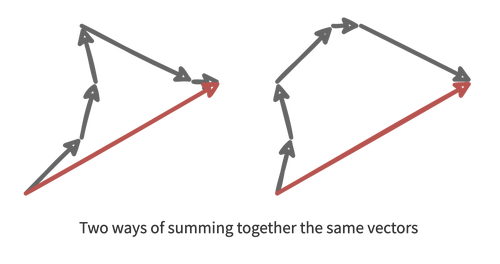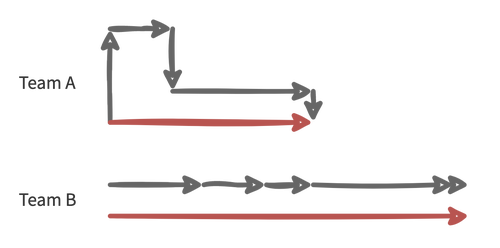Vectors of alignment
I often believe that I need to write something completely new. But as I read more and more leadership articles, I realise that a lot of them cover the same ground. Even so, I find value in reading multiple takes and adaptations on the same idea. So I can write my own thoughts and contribute to this variety of interpretations. And, anyway, there is value for myself in writing down my versions of things, so I might as well. Here’s one of those things.
This is an idea I came across several years ago. It helped me to understand why creating alignment between individuals and teams is so important to the success of an organisation. It’s the notion that one can use vectors to model how individuals in an organisation contribute to the whole, and why aligned teams are so powerful.
A vector is a mathematical construct. It’s a description of motion in terms of two things:
- A magnitude; how fast is something going?
- A direction; where is it going?
Vectors are represented in diagrams using an arrow. The length of the arrow is determined by the magnitude of the vector. The arrow points in the direction of the vector.
Maths provides us with a way to add vectors together. Essentially we add vectors by sticking them end-to-end and then creating a single vector from the stuck together vectors’ start and end points. The following diagram shows that you can add the grey vectors in any order to get the red vector, their sum:
An important property of the addition of vectors is that the direction often has more effect than the magnitude. If all the grey vectors pointed in the same direction, the red sum vector would be much longer.
A team or organisation is a group of humans. By definition, the output of that group is the combined output of those humans. We can use vectors as an imperfect but useful mental model for this.
The amount of output generated by someone is the magnitude of their vector. The vector’s direction is towards the outcome the output leads to. There are multiple levels we can view this at:
- At an individual level, each piece of work they do can be seen as a vector, and the sum of these is the individual’s overall vector.
- At the team level, those individual vectors sum to the overall team output.
- At the company level, the sum of the team vectors speak to the output – and success! – of the company as a whole.
Compare these two teams, represented by the vectors of the team members:
Both teams have overall vectors pointing in the right direction, but by making the individual vectors point in the same direction, Team B’s magnitude is much higher.
We can imagine that a given individual, organisation or company wants to produce the greatest magnitude heading towards the right outcome. In order to generate the most value, we want both a large magnitude (a large amount of output) and that output to be directed towards the right goal. As we saw in the diagram above, the way to do this is to align the vectors as closely as we can.
The notion of aligning the vectors to produce the greatest motion towards the most valuable goals speaks to the task of leaders in communicating clearly to goals of the team, organisation or company to each individual. If each person can understand the goal of the organisation and how their work fits into that goal, they can work towards aligning their own vectors towards that goal. As the people in the organisation come into alignment individually, their success will compound into greater value generated by their teams and so into the organisation and company.
There are a few further lessons we can draw from this model:
- It is essential for leadership to deliver goals that are aligned with each other. If leadership sets goals that are in different directions, the vectors generated by individuals and teams will be a mish-mash, resulting in low overall magnitudes of the combined vectors. This is what causes individuals and teams to feel pulled in many directions, and for leadership to feel there is low overall velocity toward the goals they set.
- Further, effort put into communicating goals to align teams is high leverage; an aligned organisation will create far more useful output than a non-aligned one.
- We tend to judge individuals and teams by their output, but high output of stuff is not necessarily valuable unless it’s also in the right direction. Work in the wrong direction is a drag on the overall organisation; for example, badly chosen features have a maintenance tax extending far into the future.
The reality is that it’s both impossible to create fully-aligned goals, and impossible to communicate those goals with enough fidelity to create perfect alignment. Having said this, there’s a lot of value in “good enough”. So one thing I try to do in my own work is understand whether a piece of work I’m doing helps the teams I lead align toward the right goals; if it does, there’s most likely an outsize reward compared to the effort I put in. I should do it.
I tend to judge a lot of things through this lens. One reason I like OKRs as a goal setting structure is that they seek to align vectors from the highest to lowest levels in an organisation. A lot of other frameworks can be judged in this way.
Overall, I’ve used this model many times over the years, in many different situations, and it’s proved its worth in cutting through to any underlying value. I hope it’s useful to you too.


